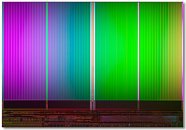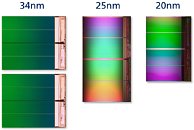- Joined
- Oct 9, 2007
- Messages
- 47,670 (7.43/day)
- Location
- Dublin, Ireland
| System Name | RBMK-1000 |
|---|---|
| Processor | AMD Ryzen 7 5700G |
| Motherboard | Gigabyte B550 AORUS Elite V2 |
| Cooling | DeepCool Gammax L240 V2 |
| Memory | 2x 16GB DDR4-3200 |
| Video Card(s) | Galax RTX 4070 Ti EX |
| Storage | Samsung 990 1TB |
| Display(s) | BenQ 1440p 60 Hz 27-inch |
| Case | Corsair Carbide 100R |
| Audio Device(s) | ASUS SupremeFX S1220A |
| Power Supply | Cooler Master MWE Gold 650W |
| Mouse | ASUS ROG Strix Impact |
| Keyboard | Gamdias Hermes E2 |
| Software | Windows 11 Pro |
Intel Corporation and Micron Technology Inc. today introduced a new, finer 20-nanometer (nm) process technology for manufacturing NAND flash memory. The new 20nm process produces an 8-gigabyte (GB) multi-level cell (MLC) NAND flash device, providing a high-capacity, small form factor storage option for saving music, video, books and other data on smartphones, tablets and computing solutions such as solid-state drives (SSDs).
The growth in data storage combined with feature enhancements for tablets and smartphones is creating new demands for NAND flash technology, especially greater capacity in smaller designs. The new 20nm 8GB device measures just 118mm² and enables a 30 to 40 percent reduction in board space (depending on package type) compared to the companies' existing 25nm 8GB NAND device. A reduction in the flash storage layout provides greater system level efficiency as it enables tablet and smartphone manufacturers to use the extra space for end-product improvements such as a bigger battery, larger screen or adding another chip to handle new features.


Manufactured by IM Flash Technologies (IMFT), Intel and Micron's NAND flash joint venture, the new 20nm 8GB device is a breakthrough in NAND process and technology design, further extending the companies' lithography leadership. Shrinking NAND lithography to this technology node is the most cost-effective method for increasing fab output, as it provides approximately 50 percent more gigabyte capacity from these factories when compared to current technology. The new 20nm process maintains similar performance and endurance as the previous generation 25nm NAND technology.
"Close customer collaboration is one of Micron's core values and through these efforts we are constantly uncovering compelling end-product design opportunities for NAND flash storage," said Glen Hawk, vice president of Micron's NAND Solutions Group. "Our innovation and growth opportunities continue with the 20nm NAND process, enabling Micron to deliver cost-effective, value-added solid-state storage solutions for our customers."
"Our goal is to enable instant, affordable access to the world's information," said Tom Rampone, vice president and general manager, Intel Non-Volatile Memory Solutions Group. "Industry-leading NAND gives Intel the ability to provide the highest quality and most cost-effective solutions to our customers, generation after generation. The Intel-Micron joint venture is a model for the manufacturing industry as we continue to lead the industry in process technology and make quick transitions of our entire fab network to smaller and smaller lithographies."
The 20nm, 8GB device is sampling now and expected to enter mass production in the second half of 2011. At that time, Intel and Micron also expect to unveil samples of a 16GB device, creating up to 128GBs of capacity in a single solid-state storage solution that is smaller than a U.S. postage stamp.
View at TechPowerUp Main Site
The growth in data storage combined with feature enhancements for tablets and smartphones is creating new demands for NAND flash technology, especially greater capacity in smaller designs. The new 20nm 8GB device measures just 118mm² and enables a 30 to 40 percent reduction in board space (depending on package type) compared to the companies' existing 25nm 8GB NAND device. A reduction in the flash storage layout provides greater system level efficiency as it enables tablet and smartphone manufacturers to use the extra space for end-product improvements such as a bigger battery, larger screen or adding another chip to handle new features.


Manufactured by IM Flash Technologies (IMFT), Intel and Micron's NAND flash joint venture, the new 20nm 8GB device is a breakthrough in NAND process and technology design, further extending the companies' lithography leadership. Shrinking NAND lithography to this technology node is the most cost-effective method for increasing fab output, as it provides approximately 50 percent more gigabyte capacity from these factories when compared to current technology. The new 20nm process maintains similar performance and endurance as the previous generation 25nm NAND technology.
"Close customer collaboration is one of Micron's core values and through these efforts we are constantly uncovering compelling end-product design opportunities for NAND flash storage," said Glen Hawk, vice president of Micron's NAND Solutions Group. "Our innovation and growth opportunities continue with the 20nm NAND process, enabling Micron to deliver cost-effective, value-added solid-state storage solutions for our customers."
"Our goal is to enable instant, affordable access to the world's information," said Tom Rampone, vice president and general manager, Intel Non-Volatile Memory Solutions Group. "Industry-leading NAND gives Intel the ability to provide the highest quality and most cost-effective solutions to our customers, generation after generation. The Intel-Micron joint venture is a model for the manufacturing industry as we continue to lead the industry in process technology and make quick transitions of our entire fab network to smaller and smaller lithographies."
The 20nm, 8GB device is sampling now and expected to enter mass production in the second half of 2011. At that time, Intel and Micron also expect to unveil samples of a 16GB device, creating up to 128GBs of capacity in a single solid-state storage solution that is smaller than a U.S. postage stamp.
View at TechPowerUp Main Site








